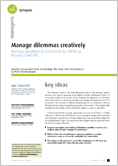Contradictions, a source of innovation?

Great leaders are able to surmount apparent contradictions to devise original solutions that bridge the two initial options. How can you draw inspiration from their example to turn dilemmas into a source of creativity?
Although not all managerial decisions are necessarily complex, some represent real dilemmas: two opposing paths appear to be irreconcilable, and neither option is fully satisfactory. Should an offering be customized, or conversely, standardized? Should you preserve a good relationship with a colleague at all costs, or let him know that his behavior is problematic?
Making such tradeoffs is not particularly easy, especially when decisions must be made collectively. To avoid divisions, disagreements, and tension, we often tend to seek a “happy medium.” Added to the mix are the classic biases of groupthink, creating a risk of partial and slanted analysis of an issue. The team may then favor a quick, low-risk compromise?but which is also uninspired and of little added value. Indeed, groupthink explains a great many decisions which, in retrospect, are clearly poor, even though they were the subject of a broad consensus at the outset. The recent flop of Juicero, the start-up that marketed a fruit juice machine for $700 and then $400, is just one example. Juicero’s idea was to emulate Nespresso’s success: the company sold sachets of washed and precut fruit and vegetables, which were then squeezed inside its machine to obtain fresh juice. Completely focused on their idea, the Juicero designers forgot to take account of the added value perceived by consumers, who could obtain the same result by squeezing the sachets by hand!
Yet, solving a complex problem is the ideal moment for a real adversarial debate. It is by discussing opposing ideas, carefully considering their respective merits, that we give ourselves the best chance of imagining new creative solutions. This process forces us to take time and put things into perspective, lay aside our assumptions and apply rigorous analytical methods. This "integrative thinking" approach, developed by Roger Martin, dean of the Rotman School of Management of the University of Toronto, is a skill that can be acquired, and undeniably helps to improve the quality of decisions.
In this synopsis:
- Challenge your certitudes to make better decisions
- Integrative thinking: A creative approach to problem solving
- Four approaches to tackle complex issues creatively
SubscriberSign in
to download
the synopse (8 p.)
VisitorI want to buy
this synopsis (8 p.)
VisitorI want
to subscribe
See also

Matters of conscience at the heart of management
How to choose between different options when none of them clearly emerges as being the best? These dilemmas make us face ourselves: What is most important for us? What do we favor? What image of ourselves do we give others?

